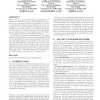Free Online Productivity Tools
i2Speak
i2Symbol
i2OCR
iTex2Img
iWeb2Print
iWeb2Shot
i2Type
iPdf2Split
iPdf2Merge
i2Bopomofo
i2Arabic
i2Style
i2Image
i2PDF
iLatex2Rtf
Sci2ools
ACMSE
2004
ACM
2004
ACM
Implementing the TEA algorithm on sensors
Sensors are tiny computers with limited computational capability and physical resources. The implementation of secure protocols for sensor network is a big challenge. In order to provide high security for sensor networks, it is very important to choose a small, efficient and effective encryption algorithm as a security primitive. The TEA (Tiny Encryption Algorithm) is an efficient algorithm that requires little memory and resources. These features make the TEA a good candidate for security mechanism for sensors. In this paper we describe an implementation of the TEA algorithm on the platform of sensor networks (Berkeley Motes). In our experiment, the data packets obtained from photo and temperature sensors are encrypted on the sensor node using the TEA algorithm. After that, they are sent to the base station by radio. The base station will receive the data packets and forward them to attached PC, where the data packets are decrypted and displayed. We also propose a particular approac...
Related Content
| Added | 30 Jun 2010 |
| Updated | 30 Jun 2010 |
| Type | Conference |
| Year | 2004 |
| Where | ACMSE |
| Authors | Shuang Liu, Olga V. Gavrylyako, Phillip G. Bradford |
Comments (0)

